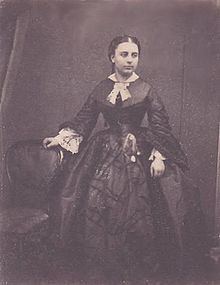Nationality Italian Occupation Opera soprano | Name Marietta Piccolomini | |
 | ||
Full Name Maria Teresa Violante Piccolomini Clementini Died December 11, 1899, Florence, Italy | ||
Marietta Piccolomini (5 March 1834 – 11 December 1899) was an Italian soprano.
Contents
Biography
Marietta Piccolomini was born Maria Teresa Violante Piccolomini Clementini in Siena (Sienna), Italy on 5 March 1834. She was descended from Italian noble House of Piccolomini, and her parents were horrified at her wanting to pursue a career in opera, but she succeeded in persuading them to allow her to do so. From the age of four years, Marietta had amused herself at playing at mock theatrical representations. She used to sing duets with her mother, a skilful amateur, and she had been instructed by Pietro Romani (1791–1877), one of the first professional singing teachers in Italy.
Marietta had long implored her father to allow her to appear on the stage. At last she prevailed and she made her debut in Rome, November, 1852, in Donizetti's Poliuto and Antonio Cagnoni’s Don Bucefalo, under the guidance of her teacher, Romani. Then she appeared in her native town of Sienna and subsequently, she went to Florence, where she performed in Lucrezia Borgia.
In Pisa in 1853, she sang Gilda in Rigoletto and in Turin in 1855 she sang Violetta in La Traviata, a role in which she became especially famous. The response in Turin was a spectacle not seen before in the world of entertainment. Throngs surrounded her hotel. Men tried to unharness the horses from her carriage so that they might draw it through the streets themselves but she would not permit this.
International career
When word of her success in Turin reached Britain, she was invited to sing the British premiere of La Traviata at Her Majesty's Theatre in London, where she appeared for the first time on May 24, 1856. In spite of the doubts raised by music critics about her technical skills as a singer, audiences received her exceedingly well and she "was adopted at once as the pet (and afterwards how much petted!) child of Her Majesty's Theatre". On June 26, Piccolomini appeared for the first time as Maria, in La figlia del reggimento, and on July 26 in Don Pasquale. Although these performances revealed her inexperience, critics praised her dramatic ability. Following her season in England, Picolomini sang in Dublin with great success.
Piccolomini's appearance in Paris in Traviata on December 6, 1856, was the first time the opera had been heard in France. Verdi tried to stop the opera from being performed at Théâtre des Italiens owing to lack of copyright for his operas in France at the time, also supporting the claims of the French holder of the rights on Alexandre Dumas's La Dame aux camélias (whence the opera is drawn), but without success. Again, while critics remarked on the limitations of her voice and singing, they praised her natural talent and stage presence. When the Empress Eugénie heard that she had missed the most talked-about premiere in Paris, she sent word to Calzado, the director of the theatre, and a command performance was arranged for the Emperor and her.
Piccolomini returned to the United Kingdom on April 21, 1857, and performed in La figlia del reggimento again and also in Don Giovanni (Zerlina), Lucia di Lammermoor and Le Nozze di Figaro (Susanna). She had been working hard to improve her technique as a result of the criticism she had received the year before. She then made a provincial tour which included Liverpool, Manchester, Birmingham, Glasgow, Edinburgh, Bath, Bristol, Cheltenham, Brighton, and other places. Then she repaired again to Dublin. In November and December she went with Giuglini on a starring tour through Holland and Germany.
In 1858 Mademoiselle Piccolomini took part both in the first experimental winter season of Her Majesty's Theatre and in the ordinary one, revisiting some of her repertoire roles and premiering La zingara, a highly successful Italian version of Balfe's The Bohemian Girl (with all recitatives set to music), and Verdi's Luisa Miller, which was not however so warmly welcome. She also performed for the first time Amina in La sonnambula by Vincenzo Bellini and Serpina in La serva padrona by Giovanni Paisiello.
After her usual tour around the provinces and in Dublin, in October she left for the United States, where she debuted at the New York Academy of Music with her favourite La Traviata, and then moved to Philadelphia and several other large American cities, proposing her repertoire of operas by Verdi, Donizetti, Paisiello and Mozart, and enjoying almost as much success as in London.
In June 1859 she returned to London, appearing at the Theatre Royal, Drury Lane in sixteen or seventeen performances, the last of which being her debut in Il trovatore. After touring around the provinces as usual, she finally returned to Italy.
Marriage and retirement
In April 1860 she was persuaded by Fabio Campana's entreaties to appear for the last time at Her Majesty's Theatre in the premiere of his Almina, and the following month she married the Marquis Francesco Caetani della Fargna (1824–1906), settling in Florence. Thereafter she retired from the stage, taking only part in rare charity concerts or making courtesy appearances. In 1863, however, she heard of the preparations in London for some benefit concerts in honour of Benjamin Lumley, the former impresario of Her Majesty's Theatre, who had launched her international career seven years before and who was by then ruined. Driven by gratitude, she decided on her own initiative to make the long journey to London and took part in the performances which, given the unavailability of Her Majesty's Theatre, had to be held at the Drury Lane.
Marquise Caetani della Fargna died of pneumonia on 11 December 1899 at her villa in Florence. She is interred in the Cimitero delle Porte Sante at the Basilica di San Miniato al Monte.
